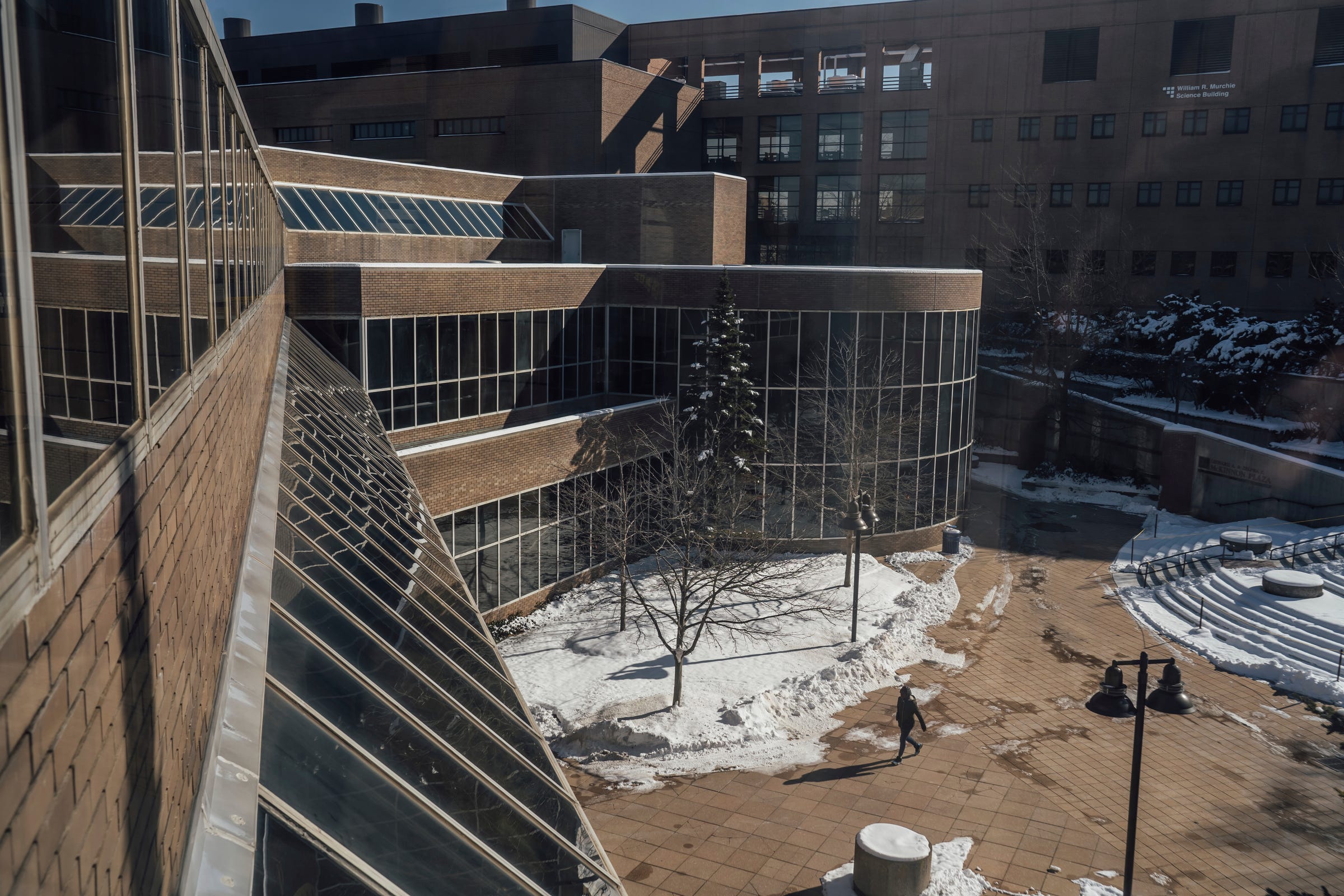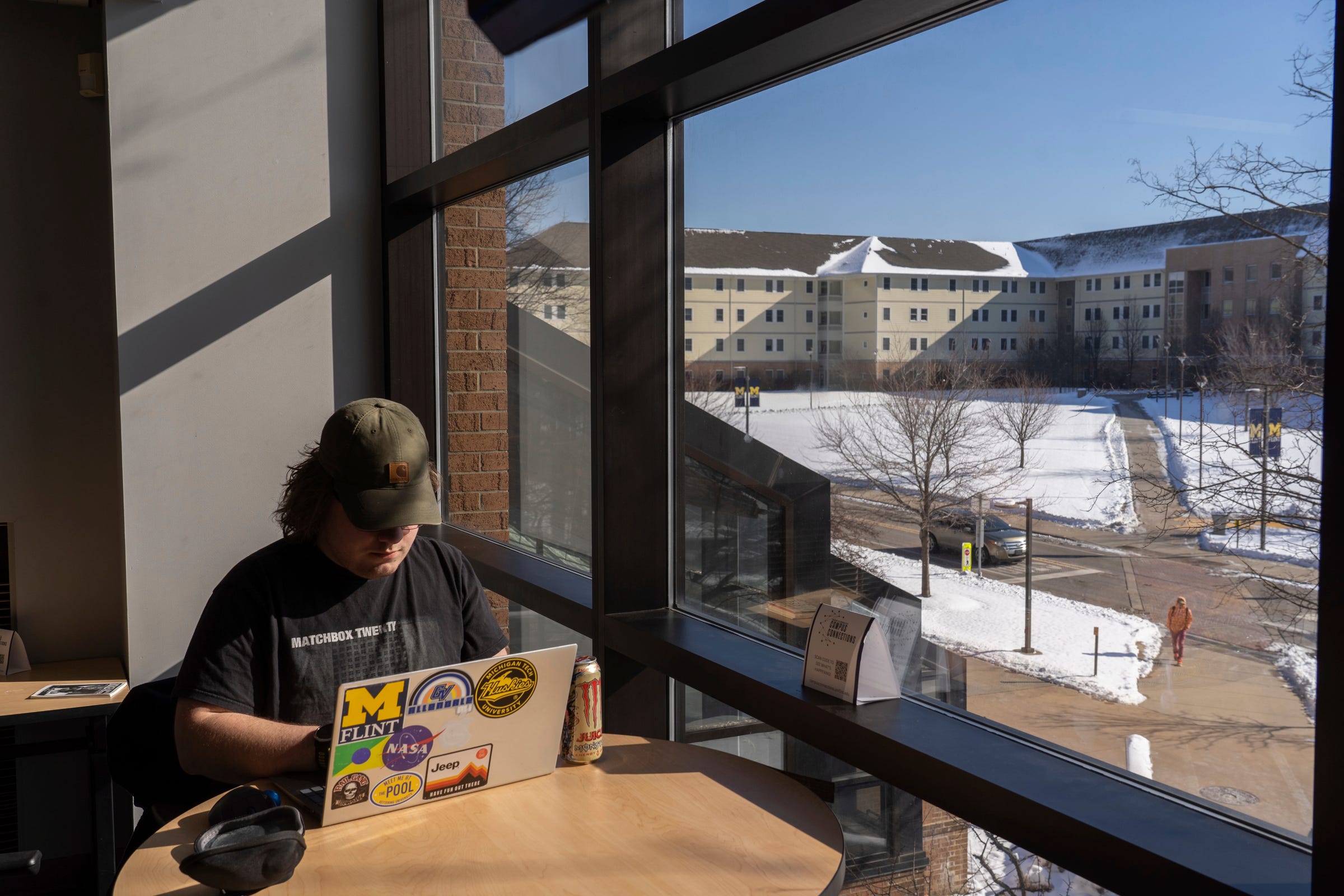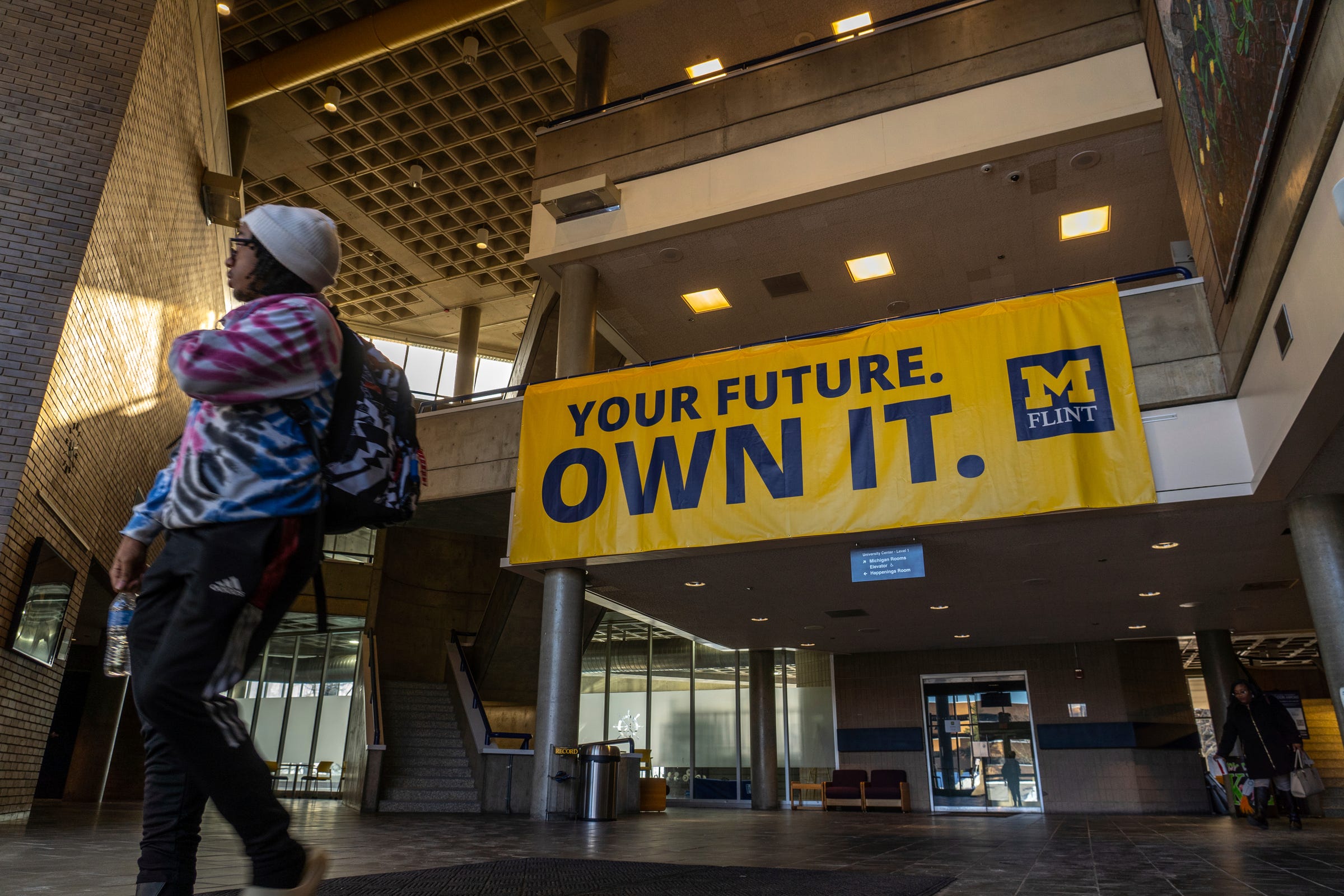
U-M Flint students wait to have their photo taken and walk across the stage during the commencement for the U-M Flint College of Arts and Sciences on Dec. 18, 2022, at the Riverfront Conference Center in downtown Flint. RYAN GARZA, DETROIT FREE PRESS
What focus it should have is currently the subject of conversations around the campus that occupies one end of Flint's downtown.
U-M Flint students wait to have their photo taken and walk across the stage during the commencement for the U-M Flint College of Arts and Sciences on Dec. 18, 2022, at the Riverfront Conference Center in downtown Flint. RYAN GARZA, DETROIT FREE PRESS
FLINT − In the lobby, they shucked their coats, straightened their gowns and made sure their caps were securely perched atop their heads. They headed toward the hall where the ceremony was about to start, walking past a table with small mirrors, bottles of static spray and lint rollers galore.
Inside the large ballroom, they were shown to their seats by smiling university employees. Once seated, they passed the time by taking selfies with family members who were along for their big day, including several with their own children. "Take a deep breath, you've made it," one employee told a soon-to-be-graduate who was looking a little stressed.
Then, after a few speeches, names were called, diplomas were handed out. The December 2022 graduates of the University of Michigan-Flint's College of Arts & Sciences were officially done.
It's a scene that has been repeated time and again since students first walked into U-M Flint — then known as Flint Senior College — in fall 1956. But in recent years, the numbers of students at the school have shrunk and its graduation rate has dipped. There have been financial struggles as well, leading to cuts and rising faculty concerns about the future direction of the school.
U-M Flint is one of three campuses making up the University of Michigan system. The other two campuses are in Ann Arbor and Dearborn. Each operates largely as its own entity, including receiving separate funding from the state of Michigan. However, the chancellors of Flint and Dearborn report to U-M President Santa Ono and all three campuses are overseen by the Board of Regents.

"It is really a system that has three distinct but aligned campuses," Ono told the Free Press in a recent interview. "Each of them makes a contribution (to the overall higher ed system in the state). I think it (U-M Flint) is very much needed."
It might be needed, but questions regarding the form, size and academic focus it should have moving forward are currently the subject of conversations, both formal and informal, around the campus that occupies one end of Flint's downtown. The answers will directly impact whether U-M Flint's future is that of a thriving university — with thousands of students restoring vigor to the downtown of a once-prosperous city — or one that is marked by a collection of mostly empty buildings standing as a symbol of what could have been.
The answers — or at least some sort of direction — will come through a formal study process now ongoing. There is no set date for a final report to be issued.
In late August, then-U-M President Mary Sue Coleman told the Flint campus leadership it needed to conduct a "transformation" study to determine the course of the campus' future. In a letter explaining the move, Coleman cited a 25% decline in enrollment over the last seven years and six-year graduation rates ranking at the bottom of the 15 public universities in the state. The latest figures show 1 in 3 U-M Flint students graduates in six years.
“We must make changes, and they must be bold, if U-M Flint is to thrive,” Coleman said at a Board of Regents meeting announcing the move.

In other words, U-M Flint needs to find a way out of the current downward spiral.
"We've not been attractive for what the students are considering when they are considering what college to attend," U-M Flint Chancellor Deba Dutta told the Free Press recently. "In this competitive environment, we have lost ground. We have to make it up."
The overall U-M system is ready to invest up to $100 million into the Flint campus, officials said, with the goal of not only turning U-M Flint around but growing it and stabilizing it, as well as the surrounding city of Flint.
But even that money has sparked fears among faculty and staff. Several told the Free Press they are concerned about which programs would get the funding and whether the university might withhold some of that funding from faculty who have raised concerns about the school's leadership. A dozen faculty members spoke with the Free Press on the condition of anonymity because of fears of retribution.
Fewer students, fewer dollars
As the mid-December commencement ceremony concluded, a big smile creased Catherine Aucompaugh's face as she switched the tassel on her cap from one side to the other, signifying she was now a graduate.
Like many of those graduating in the December exercise, Aucompaugh, 28, took a nontraditional path to obtain her college degree. As she was getting ready to graduate from Flint's Kearsley High School, she met with representatives from both U-M Flint and the Navy. She found out how expensive college was and decided that going into the Navy to get help paying for college, plus the opportunity to travel and serve her country, was too great a draw. When she got out of the Navy, she enrolled in Mott Community College in 2016 and got an associate degree before transferring to U-M Flint, which she attended from 2019 to 2022.
Like many of her class, she had a different college experience than she thought she would have, thanks to the pandemic. But her professors rallied, were helpful and offered support. She learned to keep pushing forward and to adapt.
She did notice a drop in the number of students involved in student organizations — something tied to both pandemic restrictions and the dwindling number of students attending the university.
The 2010s and early 2020s haven't been kind to U-M Flint in terms of enrollment. It has seen its undergraduate enrollment — which accounts for the bulk of its students — decrease every year since fall 2013, when 7,143 students were taking classes. This fall, there are 4,609 undergraduates on campus. That's a 35% decrease.
This fall, 1,376 graduate students also enrolled, down slightly from the 1,423 graduate students enrolled the previous fall.
Administrators, however, point to some positive signs: 76.4% of first-year students last fall came back for their second year this fall, a five-year high in that rate. More students — 330 — are living on campus this fall than last fall, when 232 did. That's just 31 short of pre-pandemic levels.
A variety of factors play into the drop. Nearly every regional university in Michigan has seen steep enrollment decreases, thanks to a dwindling number of students graduating from high school each year, the result of people moving out of Michigan and a declining birth rate.
More:Michigan colleges feeling pinch, compete over shrinking pool of prospective students
Then there's the fallout in Flint's reputation, thanks to factory closings and the water crisis. Administrators say that narrative shouldn't dominate the conversation about Flint.
"It's a perception, not a reality," Dutta, the chancellor, said. "This is an iconic city."

None of that talk, however, changes reality: U-M Flint's enrollment is really hurting. And when enrollment drops, so do bank accounts. U-M Flint made a series of budget cuts, including big cuts to lecturer ranks, salary reductions and freezes on various projects and hiring in 2020.
More:U-M Flint cuts 41% of lecturers, citing dire financial outlook
In a town hall this fall, Dutta said early projections for fiscal 2023 show a $13.9 million budget deficit. Falling enrollment plays into that, Dutta said, creating a situation where U-M Flint's student-to-faculty ratio is 13.6 to 1. At most other regional universities in Michigan, the ratio falls between 16 to 18 students for every 1 faculty member. While the smaller ratio means smaller classes, it also means less money coming in to cover the cost of faculty and other staff.
"This is not financially viable," Dutta said during that town hall.
Turning that around means attracting more students.
"Unfortunately, we aren't competing well against the other (Michigan public universities)," Dutta said. "We are much better than the public gives us credit for. That's something we have to proactively get the word out about."
Competition among Michigan's public universities has intensified as the number of high school graduates has shrunk. U-M Flint still primarily gets students from in its home county, Genesee. U-M Flint had 20.5% of all students who graduated from a Genesee County high school and enrolled in a college within six months show up on its campus for the 2011-12 school year, state records show. A decade later, U-M Flint had 20.9% of the same pot of students.
Seems pretty flat, but a closer look shows the problem: The pot of students was smaller, meaning fewer students on campus. In 2011-12, 323 students from Genesee County showed up as first-year students. In 2020-21, only 227 did. That's a 30% drop.
No argument over the problem
Stroll through campus buildings during the middle of a school day and you'll see a dichotomy of views.
Classrooms look like just about any other college classroom across the state. Students have laptops open, mostly taking notes while a professor lectures. Small groups work on projects while a professor circles the classroom, observing and occasionally interjecting with comments.
But at spots designed for students to eat or hang out or study together, it's a different story.

"It feels kind of empty," said Mark Freeman, 25, of Flint. He works in downtown Flint and meets his girlfriend, a student at U-M Flint, for lunch a couple of times a week on campus. "There doesn't seem like there's a big mass of students here, even though I know there are a bunch of people taking classes right now. Just seems like they could use a lot more students."
Few people on U-M Flint's campus would dispute that or the notion that changes need to be made if the school is going to survive.
Organizers of a nonofficial town hall on a snowy January evening were quick to acknowledge those sentiments, as a few dozen attendees gathered virtually and in-person.
Where the disagreements occur, however, is in how to remedy the decline.
"We need to be focused on the students we have, not just the students we want to get," faculty member Kimberly Saks, who led much of the discussion, said in her opening remarks.
Long considered a commuter college
For years, U-M Flint has recruited students with a simple pitch: Come to Flint and get a U-M degree at a greatly reduced price from a school with one of the lowest tuitions of any public university in the state.
It garnered a diverse student body, including in age, with adults and traditional-age college students sitting side-by-side in class.

Those who came to U-M Flint in the 1990s and early 2000s saw a campus bustling with students, including many first-generation students who grew up in a factory worker's house. It has largely been a commuter campus, with the first on-campus housing opening in 2007.
"My dad always wanted me to go to college," said Mary Ann Williams, who graduated in the late 1990s. "I could live at home, pay reasonable tuition and get a great education. Seems like a lot of the students I went to high school (in the Flint area) spent at least a year or two there. The faculty and staff were great."
But Williams' daughter, now a college freshman at Grand Valley State University, never had any real interest in attending U-M Flint, said Williams, who lives in Grand Blanc.
"It might have been too close to home," Williams said. "But her really big reason was that she wanted to go to a school where she could hang out with friends and do lots of social things, especially after COVID and having some time when it was hard to see anybody other than her family. That's hard for (U-M Flint) to compete with."
Future focus is still up in air
Across the Flint River from where the bulk of campus is, a vacant patch of ground is about to become the site of the first new academic building to be built on campus in 20 years. The last free-standing building to be built there was the First Street Residence in 2008.
A $10 million building for the university's College of Innovation and Technology has been approved. The 15,000-square-foot building will house various lab teaching spaces and areas designed to encourage collaboration and interdisciplinary research. It will be paid for with a combination of U.S. Department of Commerce Economic Development Grant, Mott Foundation and university funds.

It did not pass unnoticed by the campus community that the university, despite financial issues, is putting money into something as ambitious as the CIT. Dutta formed the college in 2020 to help attract students interested in cutting-edge areas of study. He envisions students coming to U-M Flint for a degree from the CIT and sticking around the city as they form or work for tech-related companies. The CIT was supported by a $10 million grant from the Mott Foundation.
But not all are excited by what they see. The fear, many faculty told the Free Press, is that U-M Flint is going to be turned into a tech school and leave the traditional liberal arts curriculum behind. They cite a preliminary report by consultants hired to study Flint, which stresses rising demand in the marketplace for computer science and technology-related degrees, while noting the decline in market demand for degrees such as English and other traditional liberal arts programs.
At a recent faculty meeting, there was discussion about different departments wanting to move under the CIT's banner in hopes of remaining funded, faculty told the Free Press. There's also confusion about when decisions will be made about Flint's future and who will decide which transformation projects will be funded and which won't.
During the October Board of Regents meeting, held on U-M Flint's campus, senior Alexiss Woodard expressed concerns about the breadth of Flint's programs being cut, especially in the liberal arts.
“Throughout my time here, however, I have seen how these programs have suffered from disinvestment, including my own program, Spanish,” Woodard said. “I am not only saddened by this, but I am extremely concerned for others. It would be a dangerous mistake to further diminish any other liberal arts or science programs from this community.”

College administrators deny the school is getting out of the liberal arts business but say they do see opportunity in technology.
Some faculty have said there hasn't been the increased enrollment the CIT was meant to bring. Dutta said patience is needed.
"We are a new player to this marketplace. Any new program takes a while to get to maturity," he said.
Dutta is preaching patience for the overall transformation as well.
"In three or four years, you ought to be able to see results; in two to three more years, you will see stability," Dutta said. "In seven to 10 years, this will be a very vibrant institution."
Contact David Jesse: 313-222-8851 or djesse@freepress.com. Follow him on Twitter: @reporterdavidj